Domestic League Formatting Around Europe: Is Swiss Football’s Reform a Good Thing?
The latest significant reform to a top-flight league structure comes in Switzerland, where the 20 clubs from the top two tiers of Swiss football agreed to a new format to come in next season. This came after serious backlash by fans who were heavily against the initial plan that was set to be introduced as of next season. The original format plan was released back in May, which caused the fans to voice their strong dismay at such an idea.
Currently with 10 teams in the Swiss Super League, the plan has always been to increase the size of the league to 12 clubs ahead of the 2023/24 campaign. At the conclusion of this season, the top two teams from the second tier will automatically be promoted to the top flight, with the third-place team taking on the bottom club from the Super League for the last spot.
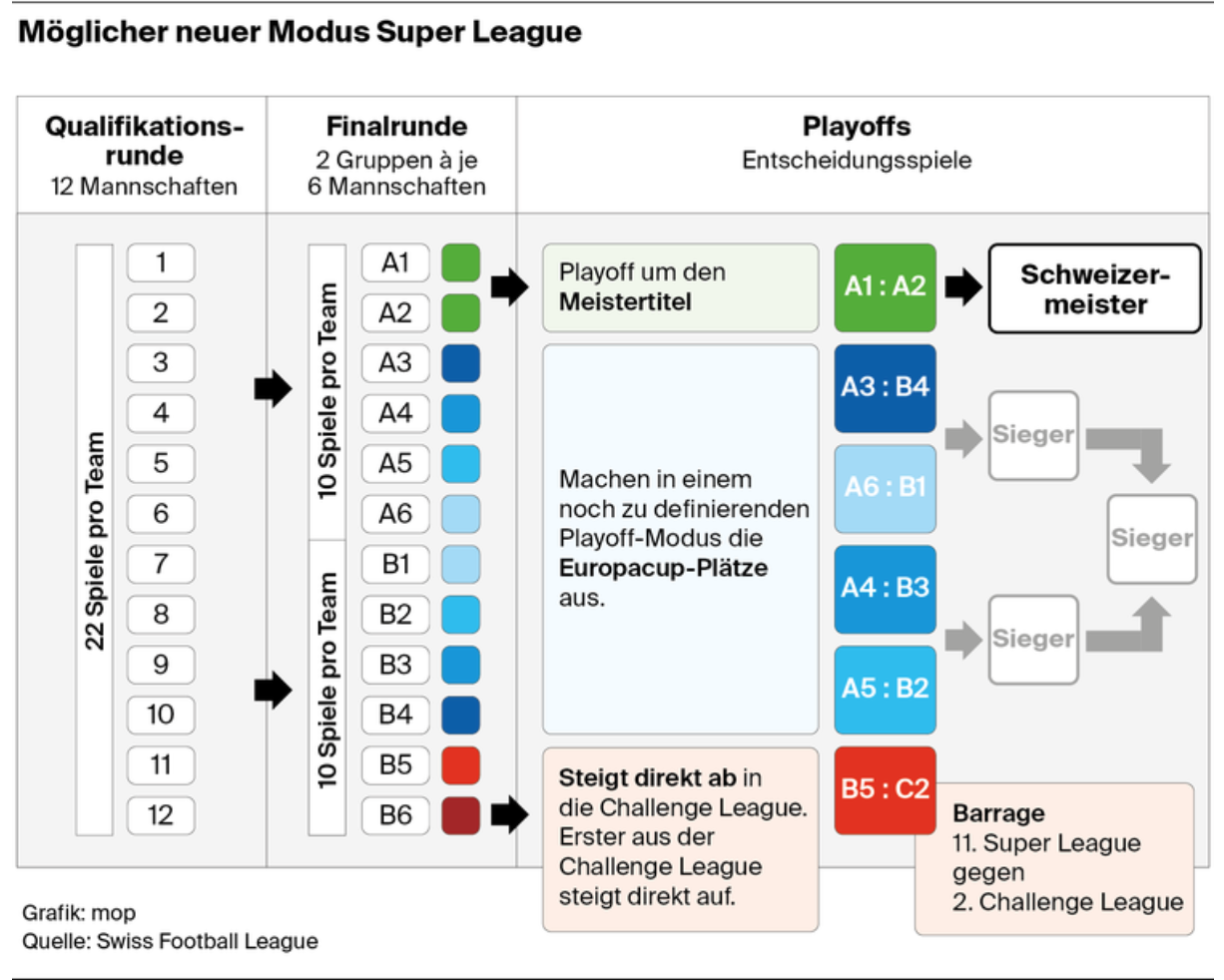
Initial Swiss Super League Reform
Approved back in May, the initial format would have seen the 12 teams meet each other home and away. After that, the league would split in half, with the top six facing each other twice more, while the same would occur with the bottom six. Following those 32 games, things would change considerably, which was the real reason for the complaints.
The top two teams would face off for the title, playing a three-game final series to determine the winner. The team that finished top after the 32 games would host the first and third matches of this final series. The bottom four teams of the title playoffs plus the top four teams of the qualification playoffs would play a knockout tournament to determine the remaining European spot(s).
The last-placed team would be relegated, while the team that finished second-bottom would partake in a playoff against the runners-up from the Challenge League, Switzerland’s second tier. However, last month, a new meeting with the 20 teams in the top two tiers saw a change of heart. With a vote of 12-8 in favour of a new format, the Swiss Football League went ahead and changed the plan. Things will be much simpler to understand as a result.
The split will still occur in the Super League, but instead of doing so after 22 games, it will transpire after 33. This means the teams will meet each other thrice rather than twice. After the split, the teams will meet each other once more with the other sides in their half of the table. The championship group will determine the title and European places, while the relegation group will decide who will go down and who will play the playoff against the Challenge League representative.
This new format is referred to as the ‘Scottish Model,’ as the Scottish Premiership adopts the same format. This has been so since 2000-01 when the Premiership – like Switzerland is about to do – increased from 10 teams to a dozen. Northern Ireland followed suit back in the 2008-09 season. In their case, they decreased their Premiership from 16 from the previous year down to 12, adding eight more games to the calendar.
Since the 2015-16 season, Northern Ireland implemented a European playoff after the 38 games. There, the bottom four teams of the championship group along with the top team from the relegation group compete for the final European spot. If any of those five teams or the top two from the title playoffs won the cup, only four teams partake in this playoff.
Change in Domestic Structure: A Recurring Theme Across Europe
The split structure in top-tier domestic leagues in Europe has started to become quite popular. Last season, a little over a third of the 54 top flights across the continent adopted some sort of split season. That number has slightly decreased this season, going down to 17. The diagram below shows the different formats used in Europe’s top divisions during the 2021/22 season.
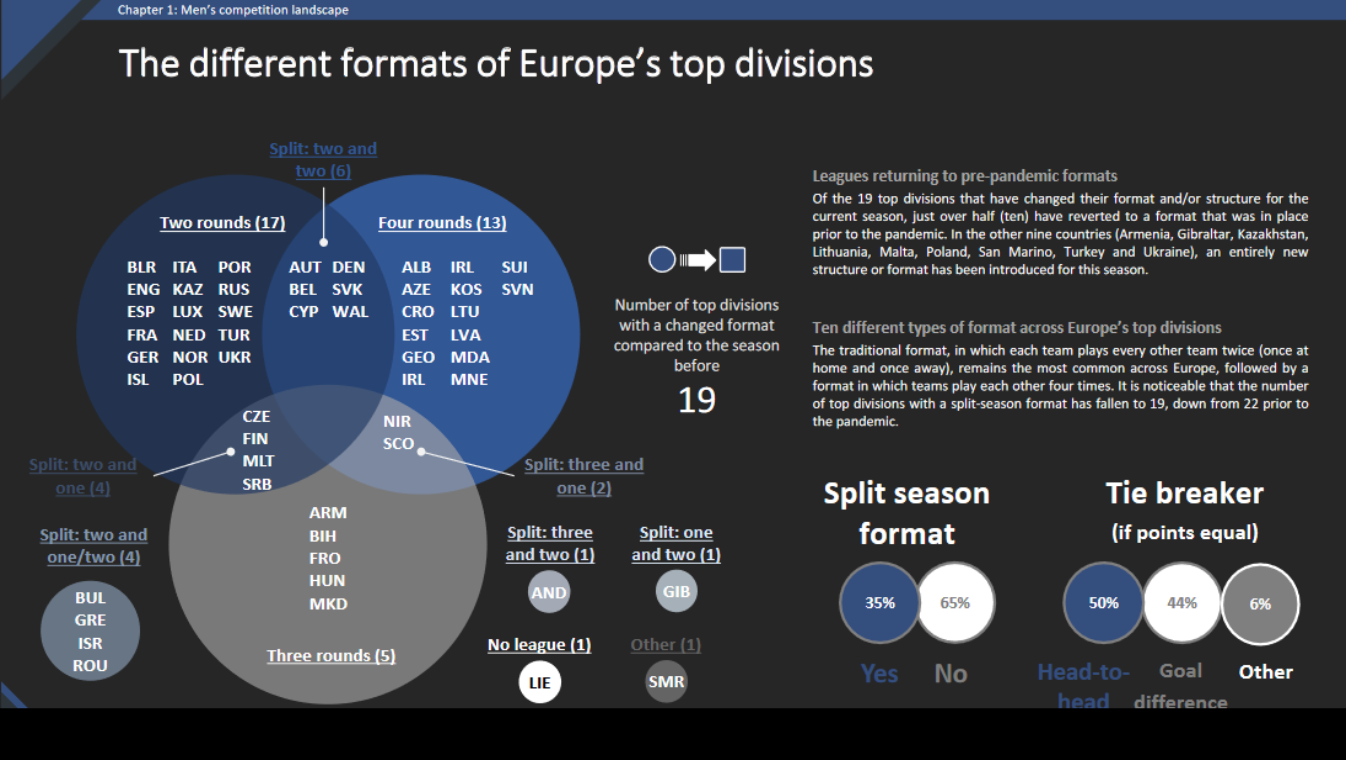
The European Club Football Landscape 2022 Edition
Looking at this season, here are the current formats used and which countries use them:
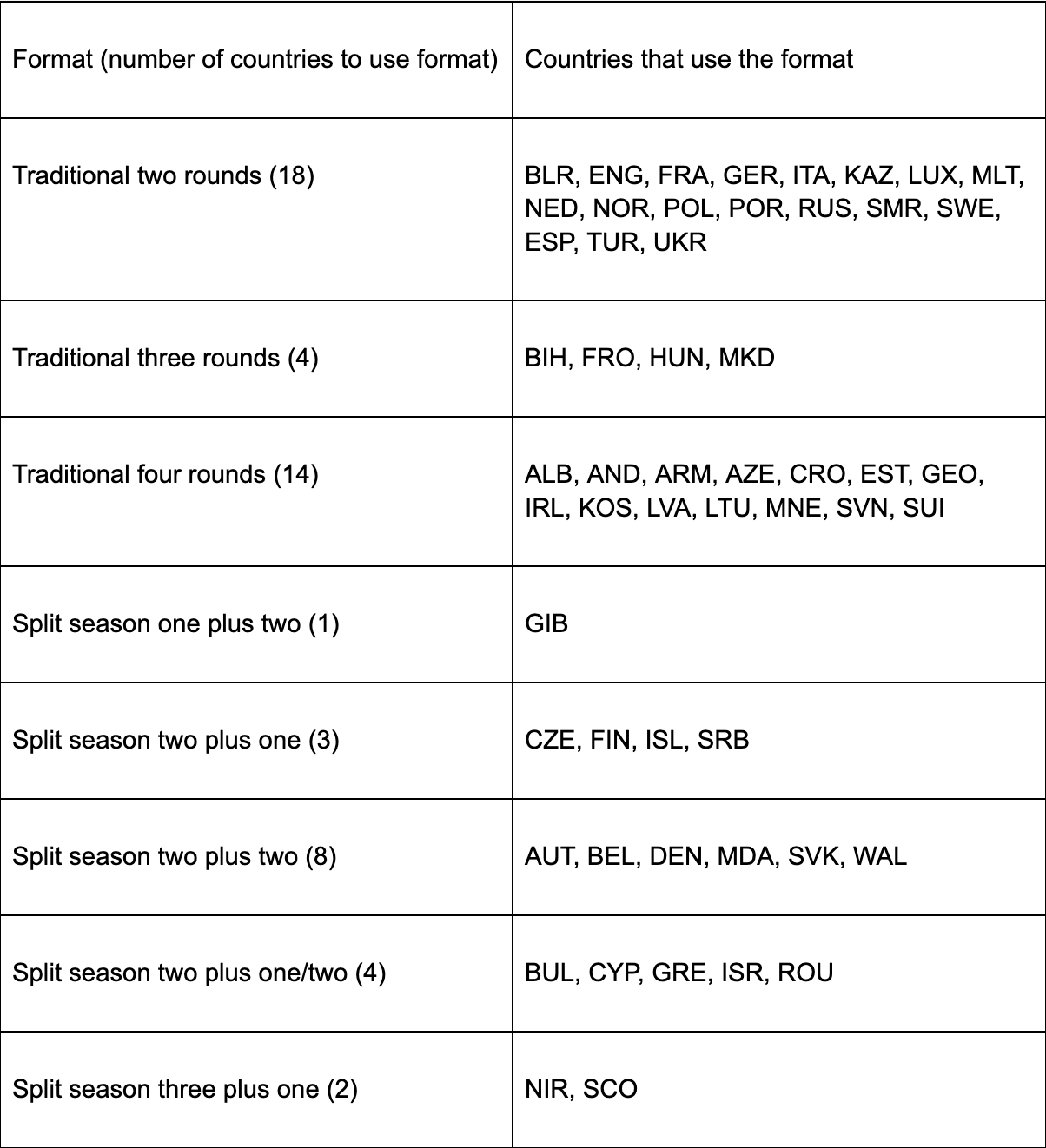
With that in mind, here is a look at the number of teams in each country’s top flight for the current season:
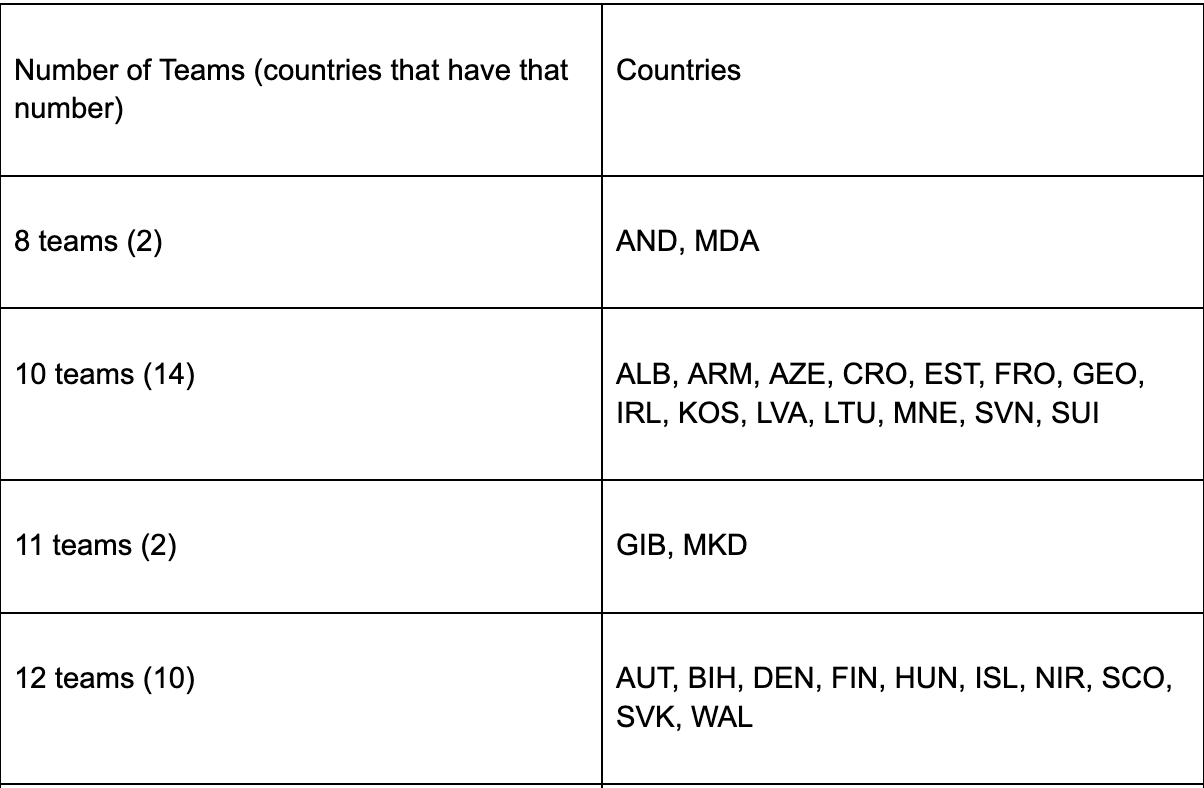
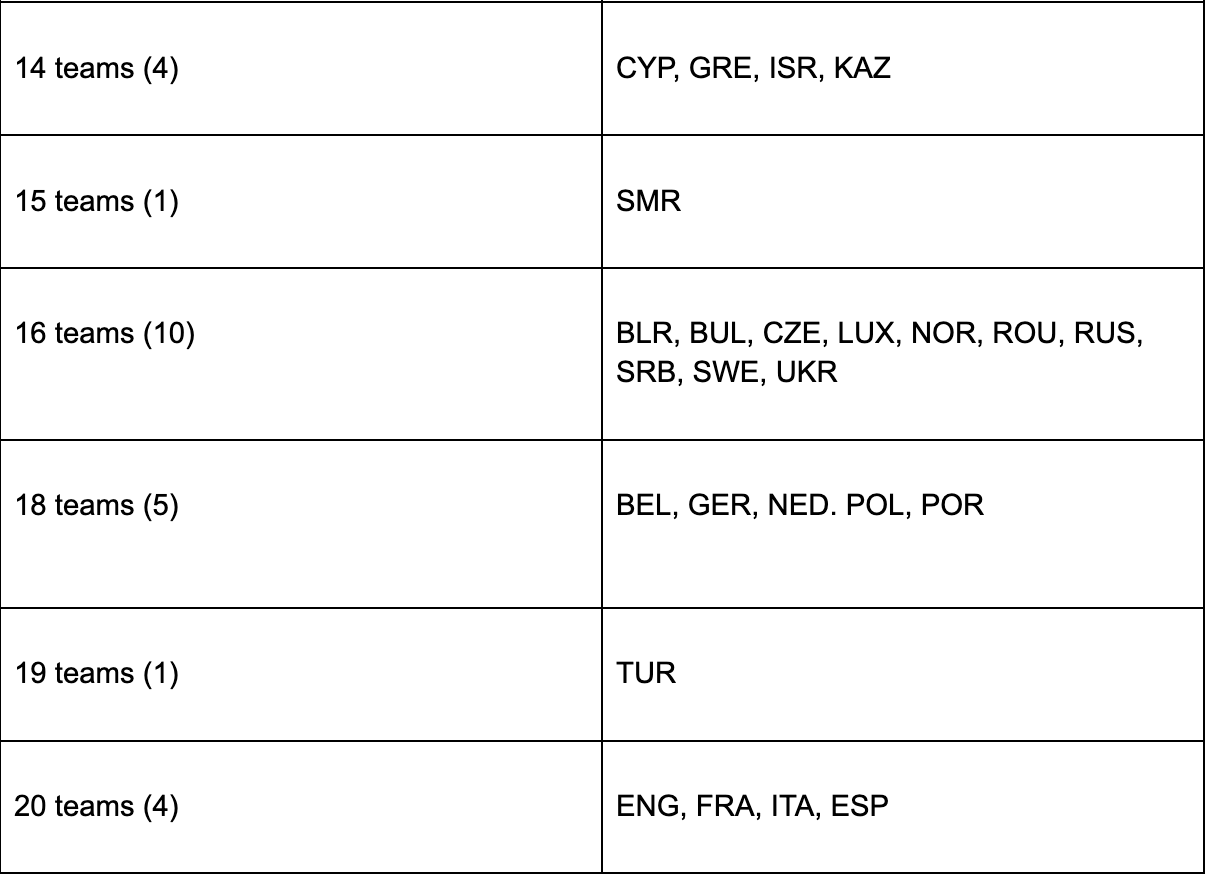
In looking at the last two tables, it gives us a better idea of which leagues prefer to use split formats. There are just 10 leagues with 18 or more teams in there, where only Belgium has a (partial) split. They will also see a change in the number of teams plus an updated format as of next season, but more on that in a bit.
The two tables above provide us with interesting conclusions when looking at formats versus the number of clubs in the league. Of the 17 leagues to adopt a split season, 12 of them come from leagues with 14 or less teams, while the remaining five come from leagues with 16 or 18 teams. This should hardly be a surprise as leagues with 15 or less teams would play less than 30 games if they were only to adopt a double round-robin format. Not only are they necessary to allow for a more complete season, but they do make the campaign more competitive on many occasions.
When looking at split tables, they almost always occur after teams meet each other home and away. As previously mentioned, Scotland and Northern Ireland do so after the teams meet thrice. Gibraltar is the only other exception, where the teams only face off once before the table breaks into half. That leaves the teams playing just 10 games before the playoffs. Moldova is the other league not to see their teams play at least 20 matches before jumping to the split, the sides only playing 14 games beforehand.
Number of Matches Across Europe’s Top Flights in the 2022-23 Season
So, where am I going with this? It seems like I am just going off on a tangent. One second, I am pointing out the new format for Switzerland’s top flight, the next I am going on about the different formats across Europe. There is a point to this, I assure you. Let us take a closer look at the total number of matches each team will or will have played in their domestic league. The numbers will vary greatly.
I will start off with the leagues where there is no split. For countries with 8-10 teams in the top flight, almost all of them will play their opposition four times. I already mentioned Moldova’s format, with the only other exception to this being the Faroe Islands, where the clubs meet thrice instead. That gives them 27 matches, versus 36 for all the other 10-team leagues (28 games in Andorra, where there are eight clubs).
For the leagues with 11-12 teams that do not split – Bosnia, Hungary and North Macedonia – they also do a triple round-robin. That means 30 matches for the teams in North Macedonia and 33 for the other two. For the countries with 14 or more clubs in their top division (and do not have a split format), it is simply a double round-robin. So, 26 games in Kazakhstan, 30 in the 16-team leagues, 34 games for each of 18 teams, 36 in Turkey, and finally 38 matches for the ‘Big 5’ leagues (bar Germany).
To no one’s surprise, the numbers for the non-split leagues vary by its size. Compare that now to the others that do have a split. The table below will show how many domestic matches teams from split leagues end up playing. This excludes European play-in matches and relegation/promotion playoffs.
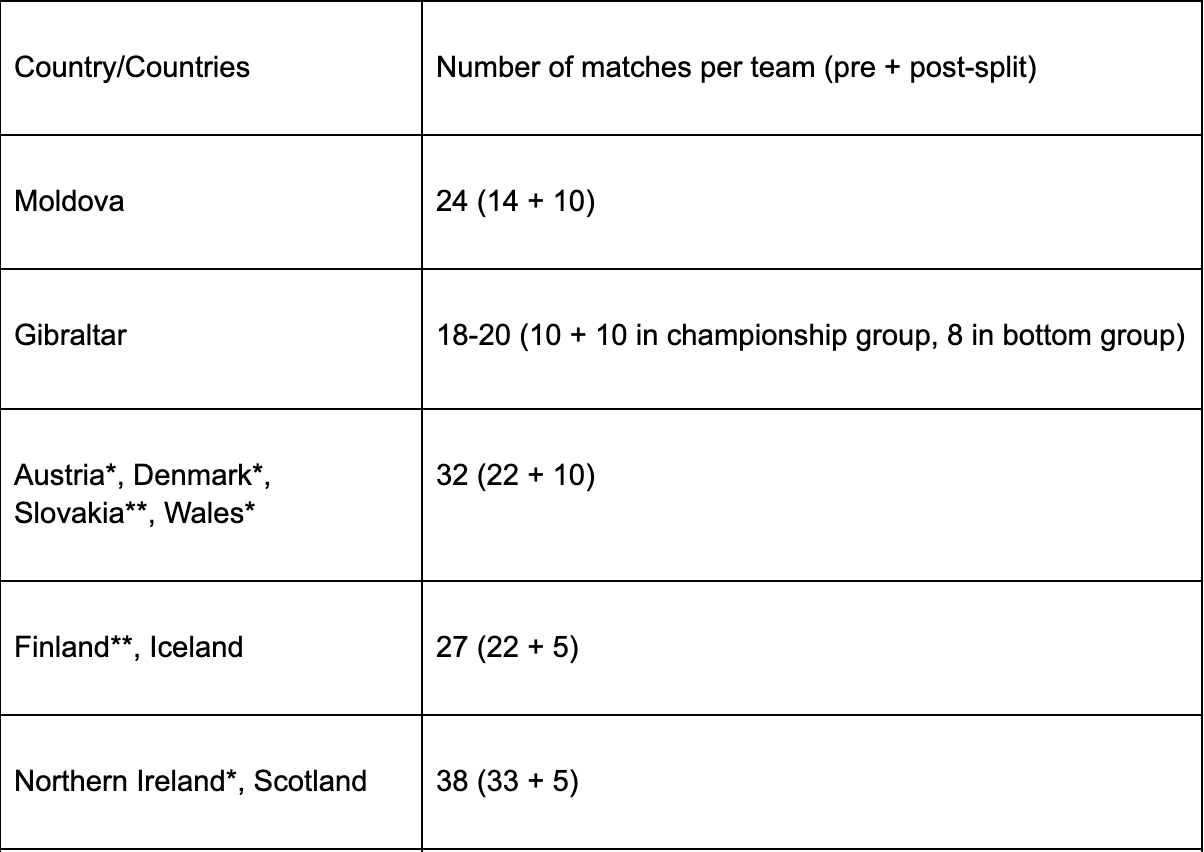
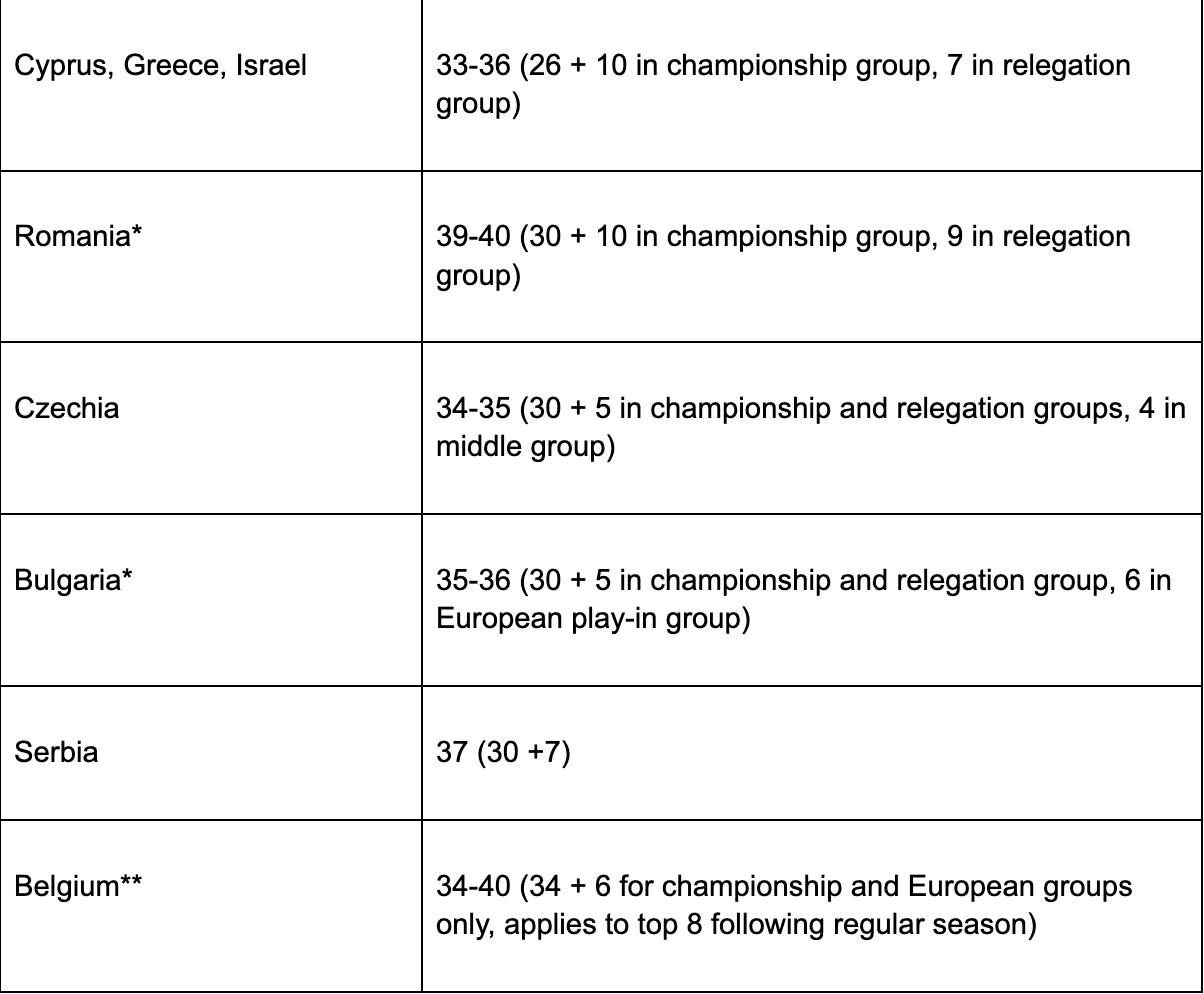
Number of domestic league matches played per team in the mentioned league
* European play-in matches used
** European play-in matches are only played if the cup winner qualifies for Europe domestically
Excluding Moldova and Gibraltar as outliers, the split leagues tend to have about 34 games on average. Mind you I did not consider European play-in matches or relegation/promotion playoffs, which typically add one or two more games.
Back to Belgium now, who are also changing league structure (in part) next campaign. They will decrease the league size, going from 18 to 16 teams. Keeping their split format, the league will have three groups after the regular season of 30 rounds. The top six will have another 10 games to play, the same applying for the teams finishing between seventh and 12th (both mini groups will see their points halved after the regular season). The bottom four teams will play six games more in the relegation playdowns.
That will result in a whopping 40 games for each of the top 12 sides in the Jupiler Pro League. Remarkably, bar the season halted by the pandemic; it has been like this for over a decade. This format initially started in 2009/10, after the Pro League decided to adopt a more exciting and competitive format to help improve their teams’ standing in European club competitions. The impact has seen something of an evolution in the domestic league structure since.
Before Belgium started the split format, only Scotland and Northern Ireland adopted such a formula, the latter doing so a season before. In other words, they were not all that common back then. But Belgium was the real pioneer of the split, as it was just a few years after that much of Europe followed suit.
The other significant thing about Belgium’s original split was that there was an extra European play-in game. The team that finished fourth in the title playoffs would take on a team that won the European playoffs, which initially featured the sides that finished seventh through 14th after the regular season. At the time, such an idea was alien to the rest of Europe.
Of the other 17 leagues to currently use a split format, nearly half of them (eight) have some sort of postseason European play-in game(s). Some of these play-in matches involve just two teams, just like in Belgium. In others, it features anywhere between three and five teams. In some cases, this play-in series only takes place if the cup winner qualifies for Europe domestically. In others, this play-in is waived if the cup winner finishes in a European place or a spot that would qualify them for this extra match.
It is also worth noting that the Netherlands also has a European playoff, involving the four highest-ranked teams that did not qualify for Europe via the league or cup. It is a knockout mini-tournament, with both rounds played over two legs. They have a history of European playoffs as well, but have used the same formula since 2008-09.
The Current State of Play in European Football Post-Qatar 2022 and What 2023 Could Bring
These split leagues and playoffs often leave fans with mixed emotions. While some do not mind the excitement and drama these playoffs and play-ins bring, others find it unfair to justify awarding European spots and titles to teams who win via a split league and/or a playoff. Despite some backlash though, it remains quite popular, hence its use in Europe.
The final thing to note on formats in Europe is the unevenness of home and away games. Of the 54 domestic leagues, five of them have an odd number of regular season games per club (Bosnia, Faroe Islands, Hungary, Northern Ireland and Scotland). That leaves half of the league’s clubs with one more game at home than away, while the other half has an extra away match.
Thing is, two of those five leagues have a split season, where the number of playoff games is also an odd number. Weirdly enough, despite an even 38 game-season between the regular season and the split, there are frequent scenarios where some sides end up with 20 home games and 18 away games or vice versa. This is one of the major drawbacks to such a system which Switzerland will be joining the two British leagues.
The Constant Concern of Overworking Players
If we are looking at the other area of concern for the new Swiss Super League format, it is an extra two games for all 12 teams, including the 2-3 promoted sides from the Challenge League. In a time where coaches and players alike constantly voice their concerns over the increasingly demanding schedule, does adding two more games help?
In fact, UEFA president Aleksandr Ceferin already wants to see a decrease in teams in the ‘Big 5’ leagues, excluding Germany. All four of England, France, Italy and Spain have 20 teams in their top flight, meaning 38 games per season. That seldom takes into consideration cup competitions, and in some teams’ cases, continental duties.
As those who read here on Breaking The Lines would know by now, the UEFA club competitions will see an increase in matches starting in the 2024-25 season. In the Champions League and Europa League, two more matches have been added in the league phase. The latter competition also sees an addition of two more qualifying rounds, with all 25 teams set to partake in those rounds required to play an extra two games in order to make a league phase.
Tension at the Tail-end – The Crazy Conclusion to the 2001/02 European Football Season
Furthermore, the knockout round playoffs, currently used in the Europa League and Europa Conference League, will be extended to the Champions League. That means another two extra games in the new year for the 16 sides that take part. As a result of these numerous changes, requested in part by the clubs, Ceferin has voiced his desire to see the top leagues slim their domestic calendars to free up more space for the revamped club competitions.
French football has obeyed, downsizing each of their top two divisions from 20 teams each to 18. On top of that, the Coupe de la Ligue – the league cup – was scrapped after the 2019-20 campaign. France’s willingness to comply with Ceferin’s wishes saw them earn another Champions League berth, taking their total European spots per season to (at least) seven, leaving them in parity with the other ‘Big 5’ leagues. England, Spain and Italy have all refused to budge so far, where no plans of a decrease in league size seem to be on the horizon.
England’s case is even more dire, as there is also a league cup played during the season. So, on top of the 38 Premier League rounds, the FA Cup, and the European club competitions, another cup tournament is added on top of it. Only seven other European countries currently have a League Cup, often taking place in preseason.
While there have been talks about reformulating domestic campaigns to free up some more space, nothing has changed at this point in either England, Italy or Spain. That brings me back to the point in Switzerland. If Ceferin seemingly deems 38 league games to be too much, why would they join in and add two extra games to an already crammed schedule?
Under the assumption that 36 is the maximum number of domestic games Ceferin would desire, that leaves England, Spain, Italy, Belgium, Northern Ireland, Romania, Scotland, Serbia and now Switzerland above that magic number. At the time of writing, only Northern Ireland and Romania are not in the top 15 of UEFA’s country ranking, meaning the remaining six associations have at least five European spots a season.
That is 5-8 teams playing 38-40 domestic games a season, on top of cup football (plus league cup in England, Northern Ireland and Scotland), and likely a dozen in Europe minimum. It could leave some of these sides with more than 60 games a season!
So, is Switzerland’s new format with 38 rounds of football a season a good thing? Is Belgium continuing with 40 games a year going to benefit their players and teams? Will England, Spain and Italy refusing to budge regarding league size cause more issues? What about Scotland and Northern Ireland, where the teams already play 38 games a season and have done so for quite some time? Will there be a point where they will have to consider decreasing the number of games? These are all very important questions to ask when looking at league size and formula.
Although the victory for Swiss football fans may have seen them avoid the potential for a truly disastrous domestic league system, is the replacement that much better? A 38-game season, where some teams could have less home games than others is not necessarily an amazing option either, especially in this day and age.
While the fears of losing revenue from two less home games are legitimate, a 32-match domestic campaign would be much more beneficial to those on the pitch. It already has been trialled and tested, and it does work. Time will tell as to whether the increase of games in Switzerland will be good or bad. The numbers are already there. Now it is a matter of sitting and waiting.
By: David Parkes / @dpnina10
Featured Image: @Juanffrann / James Williamson – AMA
